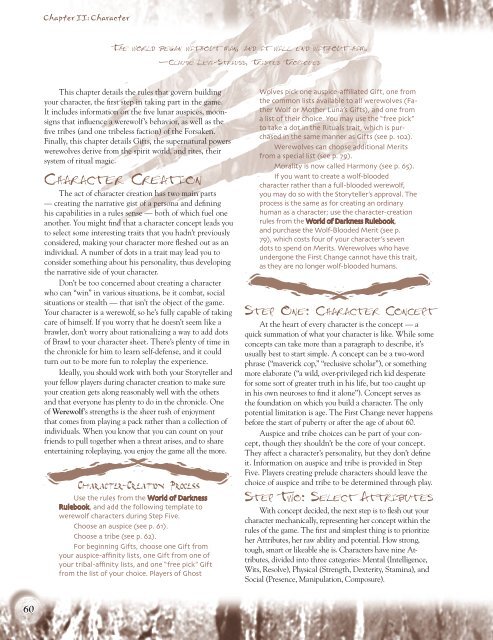Werewolf: The Forsaken - Blank It
Werewolf: The Forsaken - Blank It
Werewolf: The Forsaken - Blank It
Create successful ePaper yourself
Turn your PDF publications into a flip-book with our unique Google optimized e-Paper software.
60<br />
Chapter II: Character<br />
THE WORLD BEGAN WITHOUT MAN, AND IT WILL END WITHOUT HIM.<br />
This chapter details the rules that govern building<br />
your character, the first step in taking part in the game.<br />
<strong>It</strong> includes information on the five lunar auspices, moonsigns<br />
that influence a werewolf’s behavior, as well as the<br />
five tribes (and one tribeless faction) of the <strong>Forsaken</strong>.<br />
Finally, this chapter details Gifts, the supernatural powers<br />
werewolves derive from the spirit world, and rites, their<br />
system of ritual magic.<br />
CHARACTER CREATION<br />
<strong>The</strong> act of character creation has two main parts<br />
— creating the narrative gist of a persona and defining<br />
his capabilities in a rules sense — both of which fuel one<br />
another. You might find that a character concept leads you<br />
to select some interesting traits that you hadn’t previously<br />
considered, making your character more fleshed out as an<br />
individual. A number of dots in a trait may lead you to<br />
consider something about his personality, thus developing<br />
the narrative side of your character.<br />
Don’t be too concerned about creating a character<br />
who can “win” in various situations, be it combat, social<br />
situations or stealth — that isn’t the object of the game.<br />
Your character is a werewolf, so he’s fully capable of taking<br />
care of himself. If you worry that he doesn’t seem like a<br />
brawler, don’t worry about rationalizing a way to add dots<br />
of Brawl to your character sheet. <strong>The</strong>re’s plenty of time in<br />
the chronicle for him to learn self-defense, and it could<br />
turn out to be more fun to roleplay the experience.<br />
Ideally, you should work with both your Storyteller and<br />
your fellow players during character creation to make sure<br />
your creation gets along reasonably well with the others<br />
and that everyone has plenty to do in the chronicle. One<br />
of <strong>Werewolf</strong>’s strengths is the sheer rush of enjoyment<br />
that comes from playing a pack rather than a collection of<br />
individuals. When you know that you can count on your<br />
friends to pull together when a threat arises, and to share<br />
entertaining roleplaying, you enjoy the game all the more.<br />
CHARACTER-CREATION PROCESS<br />
Use the rules from the World of Darkness<br />
Rulebook, and add the following template to<br />
werewolf characters during Step Five.<br />
Choose an auspice (see p. 61).<br />
Choose a tribe (see p. 62).<br />
For beginning Gifts, choose one Gift from<br />
your auspice-affinity lists, one Gift from one of<br />
your tribal-affinity lists, and one “free pick” Gift<br />
from the list of your choice. Players of Ghost<br />
—CLAUDE LEVI-STRAUSS, TRISTES TROPIQUES<br />
Wolves pick one auspice-affiliated Gift, one from<br />
the common lists available to all werewolves (Father<br />
Wolf or Mother Luna’s Gifts), and one from<br />
a list of their choice. You may use the “free pick”<br />
to take a dot in the Rituals trait, which is purchased<br />
in the same manner as Gifts (see p. 102).<br />
Werewolves can choose additional Merits<br />
from a special list (see p. 79).<br />
Morality is now called Harmony (see p. 65).<br />
If you want to create a wolf-blooded<br />
character rather than a full-blooded werewolf,<br />
you may do so with the Storyteller’s approval. <strong>The</strong><br />
process is the same as for creating an ordinary<br />
human as a character; use the character-creation<br />
rules from the World of Darkness Rulebook,<br />
and purchase the Wolf-Blooded Merit (see p.<br />
79), which costs four of your character’s seven<br />
dots to spend on Merits. Werewolves who have<br />
undergone the First Change cannot have this trait,<br />
as they are no longer wolf-blooded humans.<br />
STEP ONE: CHARACTER CONCEPT<br />
At the heart of every character is the concept — a<br />
quick summation of what your character is like. While some<br />
concepts can take more than a paragraph to describe, it’s<br />
usually best to start simple. A concept can be a two-word<br />
phrase (“maverick cop,” “reclusive scholar”), or something<br />
more elaborate (“a wild, over-privileged rich kid desperate<br />
for some sort of greater truth in his life, but too caught up<br />
in his own neuroses to find it alone”). Concept serves as<br />
the foundation on which you build a character. <strong>The</strong> only<br />
potential limitation is age. <strong>The</strong> First Change never happens<br />
before the start of puberty or after the age of about 60.<br />
Auspice and tribe choices can be part of your concept,<br />
though they shouldn’t be the core of your concept.<br />
<strong>The</strong>y affect a character’s personality, but they don’t define<br />
it. Information on auspice and tribe is provided in Step<br />
Five. Players creating prelude characters should leave the<br />
choice of auspice and tribe to be determined through play.<br />
STEP TWO: SELECT AT TRIBUTES<br />
With concept decided, the next step is to flesh out your<br />
character mechanically, representing her concept within the<br />
rules of the game. <strong>The</strong> first and simplest thing is to prioritize<br />
her Attributes, her raw ability and potential. How strong,<br />
tough, smart or likeable she is. Characters have nine Attributes,<br />
divided into three categories: Mental (Intelligence,<br />
Wits, Resolve), Physical (Strength, Dexterity, Stamina), and<br />
Social (Presence, Manipulation, Composure).


